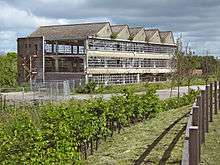Morlands
Morlands was a manufacturer of sheepskin jackets, boots and other footwear, based in Glastonbury in Somerset, England.

History
In 1870, John Morland (1838–1934) bought a tannery in Glastonbury, particularly attracted by the water (essential to the tanning process), which he described as being "of unusual purity".[1]
John Morland was Chairman from the day he founded the company until his death in 1934 at the age of 96.[2] A devout Christian he was a highly regarded speaker at Quaker meetings, both in Great Britain and abroad.[3][4] He was four times the mayor of Glastonbury and a member of the Liberal party. Both his sons and grandsons went on to become Directors of the company.
Morlands produced a range of products from sheepskin including, from the early 20th century, coats, rugs, and foot muffs for Motor car drivers. In 1928 the company made a profit of £13,867.[5] In 1940, Morlands' made flying jackets and boots for the RAF pilots who fought in the Battle of Britain although this caused some ethical discussions within the Quaker family.[6]
The company was a family business for over a hundred years before running into difficulties in the recession of the 1980s. The large tannery closed and the manufacturing process was moved to a smaller building.[7][8] Boots and gloves are still available.[9] It was part of the G.R. Holdings company in the 1990s.[10]
The 31-acre (130,000 m2) site of the old Morlands factory in Glastonbury was scheduled for demolition and redevelopment into a new light industrial park,[11][12] although there have been some protests that the buildings should be reused rather than being demolished. As part of the redevelopment of the site a project has been established by the Glastonbury Community Development Trust to provide support for local unemployed people applying for employment, starting in self-employment and accessing work-related training.[13]
References
- "History of Morlands". Morlands. Retrieved 8 April 2009.
- Morland, John (1935). John Morland of Glastonbury, 1837-1934: a Friend. J. Bellows. p. 33.
- Rowlinson, Michael (1998). "Quaker Employers". Historical Studies in Industrial Relations (6): 163–198. doi:10.3828/hsir.1998.6.5.
- Rahtz, Philip; Watts (2003). Glastonbury: Myth and Archaeology. The History Press. p. 161. ISBN 978-0-7524-2548-1.
- "Clar, Son & Morland Ltd, Glastonbury". Western Daily Press. 14 March 1929. p. 13. Retrieved 16 May 2015 – via British Newspaper Archive.
- Searle, Muriel V. (2002). West Country History: Somerset. Bristol: Venton Publications. pp. 27–29. ISBN 978-1841508023.
- "Morlands Glastonbury History". Gentleman's Gazette. Retrieved 24 December 2014.
- "Morlands". Capture Highbridge. Retrieved 24 December 2014.
- "Morlands". Morlands. Retrieved 24 December 2014.
- Whiteside, R. (2012). Medium Companies of Europe 1993/94: Volume 2 Medium Companies of the United Kingdom. Springer Science & Business Media. p. 129. ISBN 9789401114387.
- "Morlands demolition progressing well". South West RDA. 7 August 2003. Retrieved 8 April 2009.
- "Old tannery demolition continues". BBC. 9 January 2004. Retrieved 8 April 2009.
- "West Mendip Opportunities". Somerset Rural Regeneration. Retrieved 14 May 2010.
External links
| Wikimedia Commons has media related to Morlands factory, Glastonbury. |